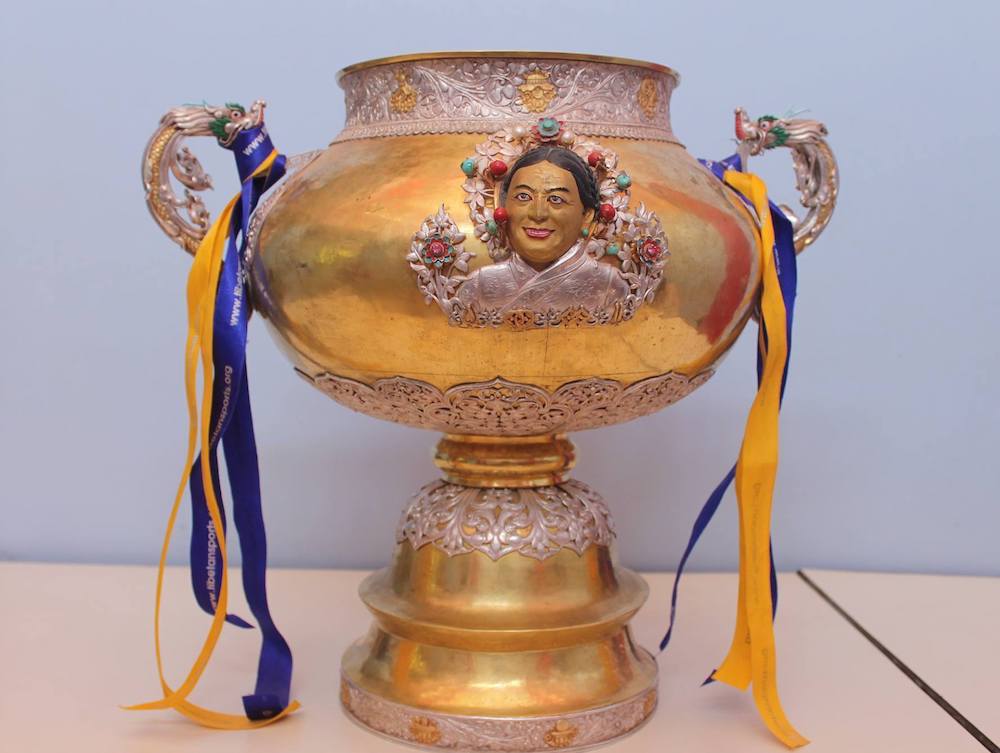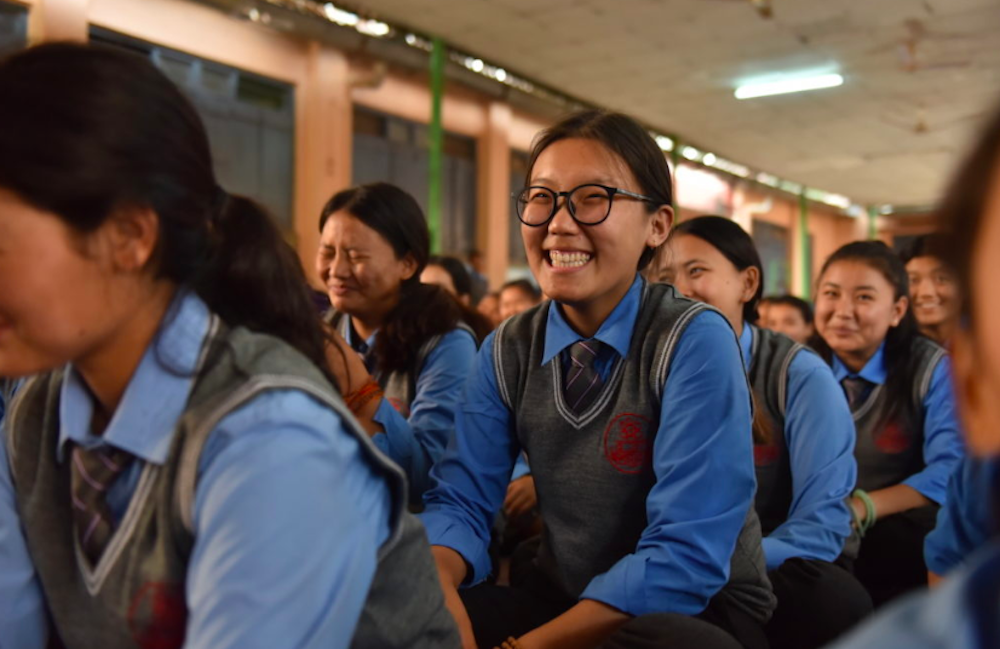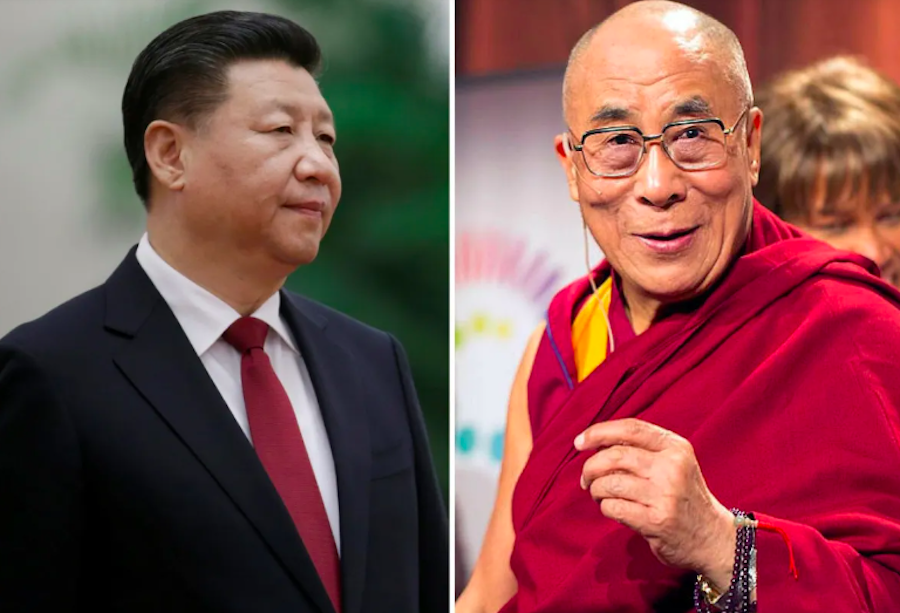 The impending enthronement of the 7th Gungthang Rinpoche illustrates the ongoing efforts of the Chinese authorities to maintain a firm grasp on Tibetan Buddhism while promoting themselves as patrons of Tibetan religious traditions. The four-year old boy is believed by Tibetan Buddhists to be the reincarnation of an influential religious figure from Labrang Tashikyil monastery (Chin: Xiahe; Gansu province, a part of the region traditionally known to Tibetans as Amdo). His selection and nomination procedures appear to have taken place through a cordial collaboration between the religious authorities and the state and the Communist Party bodies in charge of regulating religious affairs as defined by recent legislation on religion. Substantial state funding has been spent on religious institutions and communities linked to the infant lama. So far however, major attempts by the Chinese authorities to groom ‘patriotic’ religious leaders and keep them under their influence rather than that of the Dalai Lama have frequently not paid off.(1)
The impending enthronement of the 7th Gungthang Rinpoche illustrates the ongoing efforts of the Chinese authorities to maintain a firm grasp on Tibetan Buddhism while promoting themselves as patrons of Tibetan religious traditions. The four-year old boy is believed by Tibetan Buddhists to be the reincarnation of an influential religious figure from Labrang Tashikyil monastery (Chin: Xiahe; Gansu province, a part of the region traditionally known to Tibetans as Amdo). His selection and nomination procedures appear to have taken place through a cordial collaboration between the religious authorities and the state and the Communist Party bodies in charge of regulating religious affairs as defined by recent legislation on religion. Substantial state funding has been spent on religious institutions and communities linked to the infant lama. So far however, major attempts by the Chinese authorities to groom ‘patriotic’ religious leaders and keep them under their influence rather than that of the Dalai Lama have frequently not paid off.(1)
The control of the search process, identification, recognition and education of new reincarnations (Tib: tulku) is seen by the Chinese authorities as a crucial aspect of religious work in Tibet. The authorities have been particularly striving to acquire full authority over the final approval of tulku candidates. Although traditionally tulkus were identified and enthroned by Buddhist dignitaries using established procedures, the process is nowadays closely supervised by different administrative levels of the Religious Affairs Bureau and, according to official Chinese documents, should be conducted under the guidance of the Chinese Communist Party. While this may seem important for the highest reincarnations, such as the Dalai Lama and the Panchen Lama, it also applies to all the local reincarnations who traditionally play a crucial role in the religious and social life of Tibetan Buddhist communities. The territorial, social, and organizational aspects of the search, identification and enthronement process of new reincarnations is therefore subordinated to a dull and highly detailed set of bureaucratic regulations, providing a stark contrast between the administrative perception of religion by the state bodies in charge and the spiritual understanding of Tibetan people and their clergy.
 The 6th Gungthang Rinpoche Jigme Tenpe Wangchug (1926-2000) was a highly influential lama with immense popularity in the whole Amdo region. He was detained in 1958 in the course of the so-called ‘democratic reform of the religious system’ (Chin: zongjiao zhidu minzhu gaige). After his release in 1979, Gungthang Rinpoche made crucial personal contributions to the religious revival in the whole of Amdo as well as to the reconstruction of his home monastery, Labrang Tashikyil. The fact that the highest reincarnation in Labrang, the 6th Jamyang Zhepa Lobsang Jigme Thubten Choekyi Nyima (1948- ), was forced to renounce his monk’s vows and marry during the Cultural Revolution, greatly enhanced the role and status of the 6th Gungthang Rinpoche, making him a more important religious leader than he would have traditionally been. Both monks and laypeople venerated him and his pictures can be found in temples, shrines, shops and restaurants throughout Amdo. His repeated public performance of the Kalacakra initiation ritual in the 1990s attracted huge crowds of Tibetans, in some instances over 100,000, and contributed to the revival of Tibetan Buddhism. Video and audio recordings of these events are sold in bookstores in the region, and songs with lyrics composed by the 6th Gungthang Rinpoche are still very popular and often published in pirated versions.
The 6th Gungthang Rinpoche Jigme Tenpe Wangchug (1926-2000) was a highly influential lama with immense popularity in the whole Amdo region. He was detained in 1958 in the course of the so-called ‘democratic reform of the religious system’ (Chin: zongjiao zhidu minzhu gaige). After his release in 1979, Gungthang Rinpoche made crucial personal contributions to the religious revival in the whole of Amdo as well as to the reconstruction of his home monastery, Labrang Tashikyil. The fact that the highest reincarnation in Labrang, the 6th Jamyang Zhepa Lobsang Jigme Thubten Choekyi Nyima (1948- ), was forced to renounce his monk’s vows and marry during the Cultural Revolution, greatly enhanced the role and status of the 6th Gungthang Rinpoche, making him a more important religious leader than he would have traditionally been. Both monks and laypeople venerated him and his pictures can be found in temples, shrines, shops and restaurants throughout Amdo. His repeated public performance of the Kalacakra initiation ritual in the 1990s attracted huge crowds of Tibetans, in some instances over 100,000, and contributed to the revival of Tibetan Buddhism. Video and audio recordings of these events are sold in bookstores in the region, and songs with lyrics composed by the 6th Gungthang Rinpoche are still very popular and often published in pirated versions.
After his death in February 2000 the long procedure of identifying his next reincarnation was set in motion, closely followed both by the monks of the Labrang monastery and Tibetan laity. The period of uncertainty finally ended in 2004 when first the 6th Jamyang Zhepa announced the new reincarnation and later the Chinese authorities at provincial level confirmed his choice. Finally, on 29 September 2004, the official Chinese Press Agency Xinhua announced the identification of the 7th reincarnation of Gungthang Rinpoche. According to the Labrang monks, the 6th Jamyang Zhepa played a crucial role in the process and his choice is consensual. Traditionally, the Jamyang Zhepa has presided over the identification process of Gungthang Rinpoche and vice versa.
The 7th Gungthang Rinpoche Lobsang Geleg Tenpe Khenchen was born in 2002 in the village Dzoege, east of the Tsoe (Chin: Hezuo) city, the seat of the Gannan Tibetan Autonomous Prefecture in the southern part of Gansu Province. This was also the birthplace of the 3rd Gungthang Rinpoche Koenchog Tenpe Droenme (1762-1823), a famous scholar and author of a large number of Buddhist works. Currently the 7th Gungthang is residing in the small monastery of Ganden Choekhorling in Khotse (Chin: Kecai), about 100 km southwest of the Labrang monastery. The Khotse area was the birthplace of the 5th Gungthang Jamyang Tenpe Nyima (1860-1925). According to local sources, this appears to be the reason why the 7th reincarnation was brought there, a move which met with indignation from some of his fellow countrymen from Dzoege. The development of a new road between Labrang and Khotse, renovations at Khotse monastery and quite a few new houses currently under construction in the nearby village indicate that the 7th Gungthang’s presence has already brought some economic benefits to this small area.
 The 7th Gungthang is surrounded by his family, teachers and the administrators of his estate. In November 2006 he will move to Labrang Tashikyil where a large enthronement ceremony is under preparation. This will take place on the 22nd day of the 9th lunar month, one of the two days traditionally chosen by astrologers (the other is the 11th day of 2nd month) for enthronement ceremonies to take place in Labrang. In this case, this corresponds to the 12 November 2006 in the Gregorian calendar. The boy will leave the Khotse monastery on 9 November; stop at the grasslands in Sangkhog, about 10 km west of Labrang, before proceeding to Labrang on 12 November. The organization of the event is formally in the hands of the Gungthang estate but the local and provincial authorities play an important role. The provincial authorities from Lanzhou (namely the Commission for Ethnic Affairs and the United Front Department) have agreed to cover the financial costs of this large-scale ceremony. A large number of high-ranking cadres from both central authorities (State Administration for Religious Affairs, United Front Department, Chinese Buddhist Association) and provincial state and Party organizations (from the Gansu Province and neighbouring provinces with Tibetan populations: Qinghai, Sichuan, TAR), as well as representatives from the Gannan Tibetan Autonomous Prefecture, members of the entourage of the late 6th Gungthang Rinpoche, family members of the 7th Gungthang Rinpoche and his fellow countrymen will attend the ceremony.
The 7th Gungthang is surrounded by his family, teachers and the administrators of his estate. In November 2006 he will move to Labrang Tashikyil where a large enthronement ceremony is under preparation. This will take place on the 22nd day of the 9th lunar month, one of the two days traditionally chosen by astrologers (the other is the 11th day of 2nd month) for enthronement ceremonies to take place in Labrang. In this case, this corresponds to the 12 November 2006 in the Gregorian calendar. The boy will leave the Khotse monastery on 9 November; stop at the grasslands in Sangkhog, about 10 km west of Labrang, before proceeding to Labrang on 12 November. The organization of the event is formally in the hands of the Gungthang estate but the local and provincial authorities play an important role. The provincial authorities from Lanzhou (namely the Commission for Ethnic Affairs and the United Front Department) have agreed to cover the financial costs of this large-scale ceremony. A large number of high-ranking cadres from both central authorities (State Administration for Religious Affairs, United Front Department, Chinese Buddhist Association) and provincial state and Party organizations (from the Gansu Province and neighbouring provinces with Tibetan populations: Qinghai, Sichuan, TAR), as well as representatives from the Gannan Tibetan Autonomous Prefecture, members of the entourage of the late 6th Gungthang Rinpoche, family members of the 7th Gungthang Rinpoche and his fellow countrymen will attend the ceremony.
 After his enthronement, the 7th Gungthang Rinpoche will reside in the traditional estate (Amdo Tib: nangchen) of the Gungthang Rinpoches in Labrang Tashikyil, which is located in the south-western part of the monastery near the Gungthang choerten. The forthcoming event has triggered a range of construction and renovation activities in Labrang. Work on the Gungthang choerten, (a landmark of the monastery), the Avalokitesvara Temple and the faculty of Tibetan medicine are underway; as well as the re-construction of the Hayagriva Temple which was destroyed during the 1960s and remains one of the few temples which so far has not been rebuilt. According to local sources, the building of a new road between Linxia and Xiahe is also associated with the enthronement and the expected arrival of a number of high-ranking cadres.
After his enthronement, the 7th Gungthang Rinpoche will reside in the traditional estate (Amdo Tib: nangchen) of the Gungthang Rinpoches in Labrang Tashikyil, which is located in the south-western part of the monastery near the Gungthang choerten. The forthcoming event has triggered a range of construction and renovation activities in Labrang. Work on the Gungthang choerten, (a landmark of the monastery), the Avalokitesvara Temple and the faculty of Tibetan medicine are underway; as well as the re-construction of the Hayagriva Temple which was destroyed during the 1960s and remains one of the few temples which so far has not been rebuilt. According to local sources, the building of a new road between Linxia and Xiahe is also associated with the enthronement and the expected arrival of a number of high-ranking cadres.
 All the circumstances related to the enthronement of the 7th Gungthang Rinpoche illustrate that the Chinese authorities are well aware of the importance of this reincarnation in the Amdo area. The full-scale religious, organizational and building activities show that they have the process firmly in hand and the large sums of money spent demonstrate the will of the state and the Chinese Communist Party to be seen to be respecting religious freedom and ready to financially support important religious events, thus prospectively gaining the hearts of the Tibetans. The state propaganda machine will undoubtedly cover the enthronement, and picture and reports about it will appear in the Chinese media and English language publications about Tibet and ethnic minorities. However, only the future will show how the young reincarnation will handle the inner conflict between the expectations of Chinese authorities for him to provide a role model as a loyal and ‘patriotic’ Tibetan Buddhist leader of a new generation, and the expectations of the Tibetan Buddhist community to re-enact the role of his predecessor and achieve his status, popularity and knowledge.
All the circumstances related to the enthronement of the 7th Gungthang Rinpoche illustrate that the Chinese authorities are well aware of the importance of this reincarnation in the Amdo area. The full-scale religious, organizational and building activities show that they have the process firmly in hand and the large sums of money spent demonstrate the will of the state and the Chinese Communist Party to be seen to be respecting religious freedom and ready to financially support important religious events, thus prospectively gaining the hearts of the Tibetans. The state propaganda machine will undoubtedly cover the enthronement, and picture and reports about it will appear in the Chinese media and English language publications about Tibet and ethnic minorities. However, only the future will show how the young reincarnation will handle the inner conflict between the expectations of Chinese authorities for him to provide a role model as a loyal and ‘patriotic’ Tibetan Buddhist leader of a new generation, and the expectations of the Tibetan Buddhist community to re-enact the role of his predecessor and achieve his status, popularity and knowledge.
1:The issues surrounding the recognition of a new Buddhist reincarnation in Tibet was highlighted in 1995 when the choice of the 11th Panchen Lama stirred up a controversy between the Dalai Lama and the Chinese government. The Beijing-chosen Panchen Lama is effectively ignored by the Tibetan population; his portrait hangs mostly in official environments only. Meanwhile, in a gesture of quiet defiance, many Tibetans still exhibit numerous portraits of the former incarnation in their homes. An attempt to exert close control over the Karmapa, head of the Karma Kagyu school of Tibetan Buddhism, failed when the Karmapa secretly escaped to India in 2000.









